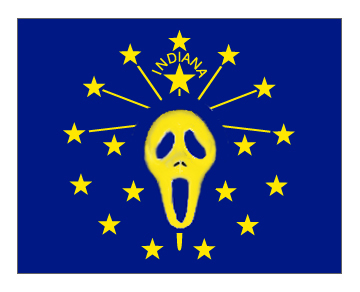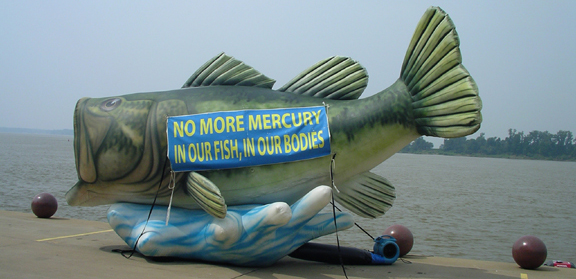June 3, 2012-By Ryan Sabalow in Star Watch in the Indianapolis Star
 About a mile south of Lucas Oil Stadium in Downtown Indianapolis, Tony Chao stood fishing one recent morning on the bank of the White River.
About a mile south of Lucas Oil Stadium in Downtown Indianapolis, Tony Chao stood fishing one recent morning on the bank of the White River.
A few feet behind his back, a sign warned not to wade into the water. Too much raw sewage in there. A sign to his left warned “not all fish are safe to eat.” Some have too many toxins in their meat.
When asked whether he actually eats what he catches, Chao, 55, gave a look that might best be described as “are you serious?”
Chao’s three fishing rods were propped up next to a pile of someone else’s discarded beer cans, sport-drink bottles and soggy carpet pieces.
Beyond the trash, across the river, a white cloud puffed up from a smokestack.
“I don’t think people eat the fish here,” Chao said.
And for good reason.
- Map of Indiana’s impaired waters
- Indiana State Department of Health’s fish advisory
- EPA’s mercury and air toxics standards
This stretch of the White River — like so many other Hoosier waterways — contains species of fish that have tested positive for mercury and other pollutants called PCBs, synthetic chemicals so toxic federal officials banned them more than three decades ago.
That there are concerns about the water quality of Indiana’s rivers, lakes and streams is not new. But environmentalists are increasingly worried the state has become passive about the problem, even as Indiana’s regulators and industry officials say they’ve made significant progress monitoring and reducing the toxins in Hoosier waterways.
In a draft report about to be submitted to the U.S. Environmental Protection Agency, state environmental management officials say there are nearly 1,000 stretches of Indiana streams, rivers and lakes where fish have PCBs and mercury in their bodies.
But while other states have created action plans specifically geared toward reducing the contaminants in fish, Indiana hasn’t.
And that concerns environmentalists who say state officials, prompted by a long-standing reluctance to regulate industrial polluters — particularly the coal-fired power plants that dump more than 4,000 pounds of mercury into the environment in a single year — are putting the public at risk.
“We know what the problem is”
At the heart of current debate is the Indiana Department of Environmental Management’s handling of mercury and PCB contamination in a biennial water pollution report soon to be submitted to the EPA.
In the report, state water quality regulators list mercury and PCB fish-tissue contamination as a leading cause of lake and stream impairment, second only to fecal bacteria contamination.
Nevertheless, IDEM placed waterways with mercury and PCB-contaminated fish on a separate, less-urgent action list.
Environmentalists say the decision, in effect, allows the state to delay dealing with toxic fish.
Unacceptable, says Bowden Quinn, conservation program coordinator for the Sierra Club’s Hoosier chapter.
He called it part of a longstanding pattern of inaction among state environmental regulators, who would rather grouse about federal agencies’ lack of funding and guidance instead of actually doing something to get toxins out of the state’s waterways.
For mercury at least, he said, that means forcing one industry to curb how much gets dumped into the environment.
“We know what the problem is,” Quinn said. “It’s coal.”
According to the EPA, coal-burning power plants are the largest human-caused source of mercury in the U.S., accounting for more than 50 percent of all the nation’s airborne mercury emissions.
In Indiana, coal power plants released more than 4,000 pounds of the element into the environment in 2010, the last year numbers were compiled by IDEM. Industrial boilers, foundries and incinerators accounted for 1,000 more pounds that year.
In 2008, Indiana was the seventh-largest source of mercury pollution in the country, according to the EPA’s most recent figures.
Advisories issued
The source of PCB pollution is less easy to pinpoint.
PCBs, which were domestically manufactured to be used in things such as electrical transformers, plastics and floor finishes, were banned in 1979 after scientists linked them to a host of human health problems, including cancer.
PCBs seep into the water supply through such things as leaky transformers, old industrial centers and poorly maintained dump sites. Slow to break down, they linger in the environment for decades.
Mercury and PCBs have at least one thing in common: They wash into waterways and are absorbed by micro-organisms at a bottom of a waterway’s food chain.
Those organisms are eventually eaten by fish — and the anglers who catch them.
Small levels of mercury and PCBs build up over time in the bodies of animals and people. The body never flushes them out.
They’re particularly worrisome for pregnant women and young children because the toxins damage developing brains and bodies.
The problem is so widespread the Indiana State Department of Health has devoted an entire section of its website to giving anglers guidance about which waterways have contaminated fish and how much they should eat out of each one.
Falon French, outreach associate and policy researcher for the Hoosier Environmental Council, said the problem is that not everyone reads the state’s fish-consumption warning signs.
“We hear from a lot of people who fish in the waterways and don’t listen to the advisory,” she said.
Even so, instilling “fear in people where it isn’t warranted” is a bad idea, said Jody Arthur, integrated report coordinator for IDEM’s Watershed Assessment and Planning Branch, because eating the occasional fish or taking a weekend swim is largely a safe activity in Indiana’s lakes and rivers.
“Work’s being done”
State officials say they aren’t ignoring the toxins, nor being soft on industries that pollute. They just haven’t found a reduction plan that is workable for them. They also say the EPA hasn’t yet provided enough guidance and money.
IDEM officials say they’ve also made significant progress over the years in reducing mercury emissions. A decade ago, the state’s polluters were releasing more than 10,000 pounds of mercury, twice the current numbers. And the amounts are expected to drop further by the time new EPA air-quality rules take effect.
A trade group president representing investor-owned electric utilities said the EPA also has recently introduced emission standards that will force companies to put smokestack scrubbers on most of Indiana’s coal-burning power plants by 2016. And many small or older power stations will be retired because of the costly upgrades.
“Work’s being done,” said Stan Pinegar, president of the Indiana Energy Association. “It’s not like neither the utilities or IDEM are sitting on their heels here.”
The way the contaminants are listed in the EPA report, state officials say, also means Indiana will have to eventually come up with a pollution-reduction plan — just not right now.
Mercury finds its way into water from outside sources, too — power plants and other polluters across the globe, said Bruno Pigott, IDEM’s assistant commissioner of water quality. He said more study is needed to determine the sources and what needs to be done.
“It’s not a cheap process, and we want it to be scientifically defensible,” he said. “We care. We care about getting it right.”
The surest way to remove mercury from the environment would be to ban coal-fired power plants outright and switch to cleaner burning fuels such as natural gas — at a cost ratepayers likely wouldn’t appreciate, said Thomas P. Simon, a former EPA aquatic biologist, now a professor at Indiana University’s School of Public and Environmental Affairs.
Getting the remaining PCBs out of the state’s waterways, Simon said, would similarly entail costly dredging, cleaning and “literally moving tons and tons of sediment.”
“IDEM gets hammered a lot,” Simon said. “Sometimes it’s justified. But, overall, I think IDEM has done a good job, given the resources, given the manpower, given the constraints.”
IDEM and other states
But leaders in other states have devoted cash and manpower to draft plans geared toward reducing PCBs and mercury in their fish.
A coalition of New England states, as well as Minnesota and New Jersey, already have developed mercury-reduction plans, which set emission standards and timelines for polluters to get their mercury output down, said Peter Cassell, the EPA’s Midwest water-quality spokesman.
A number of states, including a coalition along the Delaware River on the East Coast, also have developed similar PCB-reduction plans that put controls on industry wastewater runoff and airborne chemical releases.
Rebecca Walter, mercury program coordinator for the Minnesota Pollution Control Agency, said her state’s reason for coming up with a mercury reduction plan was simple enough: In a tourism-dependent state that touts itself as the “Land of 10,000 lakes,” it didn’t look good that 820 of them had health advisories warning of mercury-contaminated fish.
As such, she said, Minnesota’s coal plants, mines and other industrial facilities were ordered to reduce their mercury output from more than 3,000 pounds in 2005 to 789 pounds by 2025. That’s a reduction of nearly 75 percent.
Without a specific pollution plan, Indiana’s goals are a lot less lofty.
IDEM officials say the state’s mercury emissions are expected to see a 14 percent decrease by 2018, leaving Indiana with 4,300 pounds of the toxic element still emitted into the state’s air and water each year.
Even though the EPA gives states leeway to prioritize which contaminants to target, Walter says, it’s widely expected the federal government will soon begin forcing states to come up with plans similar to Minnesota’s.
“I think the delaying isn’t going to help,” she said.
An unsafe food source
Natalie Roy, executive director of the Washington, D.C.- based Clean Water Network, said Indiana is clearly trying to “punt” responsibility of cleaning up its waterways.
“That’s pathetic,” she said.
It’s also an example, she said, of a lack of uniform federal standards that would force states to do more to clean their troubled waters.
Roy said even if states do come up with pollution plans, lack of funding and political will means they can languish on shelves for decades.
Because each state is allowed to do things differently, it also makes it difficult to determine which ones are actually making progress — or to compare Indiana with other states.
Roy didn’t hold out a lot of hope for Indiana on that front, especially after learning Gov. Mitch Daniels once argued the EPA should be renamed the “Employment Prevention Agency.”
“This is about water, for God’s sake,” she said.
French, of the Hoosier Environmental Council, said cleaning up Indiana’s streams and lakes also would help the economy.
She said not only is it fundamental for Indiana residents to have clean streams and rivers because they’re the source of the state’s drinking water, fishing is a major part of the state’s heritage and culture, something that helps drive the tourism industry and spur job growth.
Eating fish caught from local streams and lakes, she said, also could help poor Hoosiers when times get tough. Of course, the fish first need to be safe to eat.
Chao, the White River fisherman, said he had no problem fishing in a waterway so dirty officials had to put up warning signs.
For him, fishing is for fun, not food. But for those who do want to eat fish, he offers some advice.
“Go to the store,” he said. “It’s safer.”

Hi to every single one, it’s really a pleasant for me to pay a quick visit this website, it consists of useful Information.
Hi, all is going well here and ofcourse every one is sharing information, that’s truly excellent, keep
up writing.